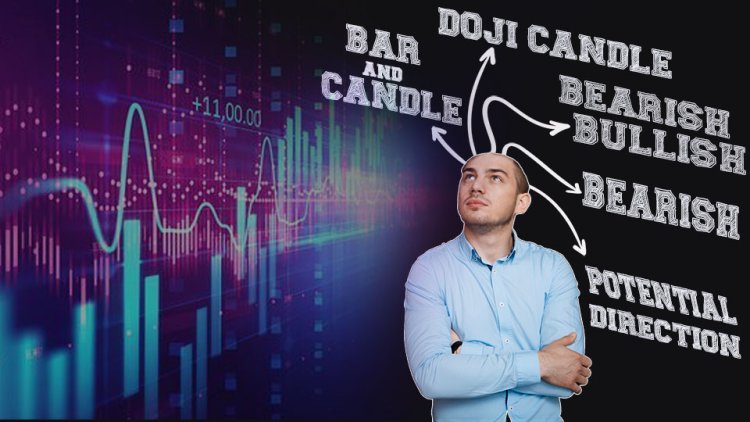Best chart for Intraday Trading and Best Nifty Candlestick Pattern
In this blog, you will be able to learn everything that you are supposed to know about candlesticks which will help you identify which type of candlestick you are seeing on your screen which helps you out in earning profit.

Mostly choice of chart for intraday trading depends totally on personal preference and the trading strategy you're using. The most used type of chart is used for intraday trading are:
Candlestick Charts: The main objective of candlestick charts is to provide detailed information about price movements within a frame of specific time. Every type of candlestick represents a specific time period (For example - 1 minute, 5 minutes) which includes open, high, low, and close prices. Candlestick charts are very popular mostly among intraday traders as they are used to provide insights into price patterns and trends.
Tick Charts: Tick charts show price movements based on a certain number of trades rather than fixed time intervals. They are especially useful for traders interested in market activity and volume-based analysis.
Price movements based
Time-Based Charts (1-minute, 5-minute, etc.): These charts plot a new candlestick at regular time intervals. They offer a balanced view of price movements and are widely used for intraday trading.
Range Charts: When a certain price range is met then new bars are used to be plotted by Range Charts. Small price fluctuations cause noise which is used to eliminate by Range Charts and it can be also used for identifying trends and support/resistance levels.
Renko Charts: Renko charts focus solely on price movement, ignoring time and volume. They create new bricks (boxes) only when the price moves by a certain predefined amount. Renko charts help traders spot trends and reversals more clearly.
Renko charts is a type of chart that is used to solely focus on price movement and ignores time and volume. They are used to create new bricks (boxes) only when the price moves by a certain predefined amount. To spot trends and reversals more clearly Renko charts help you out in that.
Ultimately, the best chart type depends on your trading style, strategy, and comfort level. Experiment with different chart types to see which one aligns with your analysis approach and helps you make better intraday trading decisions. Additionally, consider combining chart analysis with technical indicators and other tools to enhance your trading strategy.
Overall, the best type of chart for you depends on your comfort level, style, and style. You should experiment with different types of chart types and then see that which one aligns with your analysis approach and helps you make better intraday trading decisions.
Tradingview tutorial
Certainly, here's a brief tutorial to get you started with TradingView:
Account Setup:
- Now you are supposed to go to the TraingView website and then sign up for an account. For additional features, you are supposed to choose a free account or option of premium subscription.
Chart Creation:
- Then click on the "Chart tab to create a new chart after logging in.
- Now you should select the desired trading pair or financial instrument. Then choose a time frame for example 1 minute, 1 hour, on a daily basis for the chart.
Adding Indicators:
- Now to add technical indicators to your chart click on the "Indicators" button.
- Search for specific indicators like Moving Averages, RSI, MACD, etc.
- Customize the indicator settings as needed.
Drawing Tools:
- Utilize drawing tools like trendlines, channels, and Fibonacci retracements.
- Click on the "Drawing Tools" button to access these options.
- Draw directly on the chart to mark key levels and patterns.
Saving and Sharing Charts:
- To use your customized chart layout which is customized by you. You can also share your charts with others by generating a link or embedding the chart on a website.
Candlestick Patterns:
- Observe candlestick patterns like Doji, Engulfing, Hammer, etc.
- Use these patterns to identify potential reversals or trends.
Support and Resistance:
- Identify support (lower price levels where buying interest may increase) and resistance (upper price levels where selling interest may increase) zones.
- Draw horizontal lines to mark these levels on your chart.
Practice and Analysis:
- Analyze historical price movements and observe how indicators and patterns align with actual price action.
- Develop your trading strategies based on this analysis.
Community and Learning:
- Explore the TradingView community by following traders, sharing ideas, and participating in discussions.
- Utilize the "Ideas" section to find insights from other traders.
Continuous Learning:
- TradingView offers a wealth of resources, including video tutorials, articles, and webinars, to help you deepen your understanding of technical analysis and trading strategies.
- Remember that successful trading involves a combination of technical analysis, risk management, and market research.
- Continuously practice and refine your skills, and consider using TradingView as a tool to assist in your trading decisions rather than relying solely on it.
- Always do your research and consider seeking advice from experienced traders or financial professionals.
Understand Chart Structure Tradingview
- Chart structure in TradingView refers to the visual representation of price movements on a trading chart. It encompasses various elements such as candlesticks, trendlines, support and resistance levels, and technical indicators.
- Traders use chart structure analysis to identify patterns, trends, and key levels that help predict future price movements.
- By assessing the historical price data and its interaction with these elements, traders can make informed decisions about potential entry and exit points for trades.
- Chart structure analysis aids in understanding the broader market context and assists in developing trading strategies based on price action and technical patterns.
Bank nifty candlestick pattern
The Bank Nifty is an index that represents the performance of the banking sector in the Indian stock market.
Candlestick patterns are a popular tool used in technical analysis to understand price movements and predict potential market trends. Here are a few common candlestick patterns that traders often look for in the Bank Nifty:
Doji: A Doji candlestick pattern occurs when the opening and closing prices are very close or nearly equal. It indicates indecision in the market and could signal a potential reversal or trend change.
Bullish Engulfing: This pattern consists of a small bearish (downward) candle followed by a larger bullish (upward) candle that completely engulfs the previous candle. It suggests a potential reversal from a downtrend to an uptrend.
Bearish Engulfing: This is the opposite of the bullish engulfing pattern. It occurs when a small bullish candle is followed by a larger bearish candle that engulfs the previous candle. It could signal a reversal from an uptrend to a downtrend.
Hammer: A hammer candlestick has a small body near the top of the candle and a long lower wick. It indicates a potential reversal from a downtrend to an uptrend.
Shooting Star: The shooting star pattern is the inverse of the hammer. It has a small body near the bottom of the candle and a long upper wick. It suggests a potential reversal from an uptrend to a downtrend.
Morning Star: This is a bullish reversal pattern that consists of three candles: a large bearish candle, a small bearish or bullish candle, and a large bullish candle. It signals a potential shift from a downtrend to an uptrend.
Evening Star: The evening star is the bearish counterpart of the morning star. It also consists of three candles: a large bullish candle, a small bearish or bullish candle, and a large bearish candle. It suggests a potential shift from an uptrend to a downtrend.
Harami: The harami pattern involves two candles where the second candle is smaller and is contained within the range of the first candle. It could signal a potential reversal or a pause in the current trend.
Engulfing Patterns: These patterns involve two candles, where the second candle completely engulfs the first one. A bullish engulfing pattern suggests a potential reversal from a downtrend to an uptrend, while a bearish engulfing pattern suggests the opposite.
It's important to note that while candlestick patterns can provide insights into potential market movements, they should not be solely relied upon for trading decisions. Traders often use candlestick patterns in conjunction with other technical indicators and analysis methods to make more informed trading choices. Additionally, market conditions can be unpredictable, and patterns may not always lead to the expected outcomes.
Conclusion
The information provided in this blog is for educational purposes only and should not be considered financial or investment advice. Trading in stocks and securities involves risks, and individuals should carefully evaluate their financial situation and consult with professionals before making any trading decisions, you can take the help of Finskool advisory service which will increase your chances of earning profit.
What's Your Reaction?

















